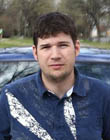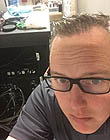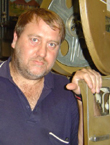|
|
This topic comprises 2 pages: 1 2
|
|
Author
|
Topic: Suggested xenon wattage
|
|
|
|
|
|
|
Andrew McCrea
Jedi Master Film Handler

Posts: 645
From: Winnipeg, Manitoba, Canada
Registered: Nov 2000
|
 posted 05-10-2006 12:23 AM
posted 05-10-2006 12:23 AM





Thanks.
At first, I was thinking 2kw would be more than enough, but then I realized the short throw onto a screen of similar size.
Because this was designed for a small town I had in mind (my little secret), #1 would seat 106 and #2 would seat 57. The idea (even though the floor would be sloped, not stadium) was to design the auditorium to provide the wall-to-wall screen in-your-face experience, like a big-city multiplex. And, I made sure that the screen was maxed in scope, with a short ceiling height, kind of too mimic one of my favourite theatres.
The lamphouse would probably be a used Super Lume-X or Super 80. Is there anyway that both could have 2500 or 3kw, and a shutter or something that could cut back the light in #2? That way, you're only stocking the same parts for the same lamphouse, with the same bulbs.
I was thinking a Simplex XL.
| IP: Logged
|
|
|
|
|
|
|
|
|
|
Steve Guttag
We forgot the crackers Gromit!!!

Posts: 12814
From: Annapolis, MD
Registered: Dec 1999
|
 posted 05-10-2006 06:56 AM
posted 05-10-2006 06:56 AM




quote: Monte L Fullmer
Sorry, Sean - you do need the throw length and the width of the scope screen
Monte, where do you get this crap? Do you just make things up? The throw has zero, notta, nill to do with the size of the xenon lamp needed. At best, some may argue that when one is at extreme long focal lengths, the light will be reduced by the focal length interraction with the exit diameter of the lens barrel (over 140mm).
As for the lamp size...Cinema 1 will be in the 3K range (Super-80 or Ultra-80...Ultra-80 has better cooling). Cinema 2 will be in the 1.6K range and a Super Lume-X (it is actually a more efficient reflector than the Super-80/Ultra-80).
As for defocusing the lamp...there really is just one proper focus point to get the light right. Yes you can defocus a lamp but it really is not the right way to get the best image or least heat. Defocusing the lens might eliminate seeing scratches too but again, it isn't the correct solution. Size the lamp properly, align the lamphouse perfectly and adjust the lamp properly. You will end up with a non-hotspotting image and coolest running gate because most of the light will be going through the film and not splattering on the back of the trap.
BTW, SMPTE is 16fL +/- 2 fL for review rooms and +/- 4fL for cinemas so enjoy your 20fL images all you want.
As for controlling the light using a larger lamp, you can also look into Schneider's new Cinelux Premier lenses...they have an adjustable iris from f/1.7 to f/4.0. This way, if you do choose to over lamp and block some light, you can pick up improved depth of focus for your efforts.
| IP: Logged
|
|
|
|
|
|
|
|
|
|
Steve Guttag
We forgot the crackers Gromit!!!

Posts: 12814
From: Annapolis, MD
Registered: Dec 1999
|
 posted 05-10-2006 01:00 PM
posted 05-10-2006 01:00 PM




There are rules of thumb on that one. The basic one is to take the screen height of your least efficent format (typcially 1.85), square that and then multiply by 12 if it is a good lamp system and appoximately 50% shutter with decent lenses or go with 13 if you are using less efficient reflectors.
So for a 10-foot tall screen with a Super Lume-X and decent lenses you have 12*10^2 or 1200-watts for a matte white screen.
As John mentioned, there are other factors that can improve or take away from the light like the port, the actual screen gain and so forth. Even the lamp package can affect the light throughput (not just output). The size of the arc and the size of the aperture have a relationship not unlike the size of a slit lens versus the HF response. Thus you find that short-arc lamps are more efficient (typically have an "HS" suffix in their name).
If you find that you have moved to the "larger" lamps say 3K and up, then you find that you should use 13 as the multiplier so for a 15' tall picture it would 13*15^2 or 2925-watts is a good target point for a typical lamphouse/console system.
As for Louis' observations on hot-spotting on short throws...there are several reasons for this...first, the screens are probably not matte-white, despite manufactur's names. Unless you are using a Stewart Snomatte 100, the screen probably has a non-matte characteristic. This will give you a hot-spot.
The lens design is another area. Schneider lenses tend to hotspot (and make the light more blue) than ISCOs. So if you combine a typical cinema screen with a Schneider lens you will tend to see a screen with the image brighter in the middle. An ISCO Ultra-Star PLUS lens (red one) will not have anywhere near the amount of hot spotting. The newer Schneider Cinelux Premier lenses are said to also provide a more even light as compared to earlier designs.
Short throws accentuate this sort of uneven illumination, as Louis notes, due to the angle the light takes to the screen and the mirror like qualities of many screens. Curving a screen properly will mitigate this but that can bring about other artifacts as discussed in other threads.
| IP: Logged
|
|
|
|
|
|
All times are Central (GMT -6:00)
|
This topic comprises 2 pages: 1 2
|
Powered by Infopop Corporation
UBB.classicTM
6.3.1.2
The Film-Tech Forums are designed for various members related to the cinema industry to express their opinions, viewpoints and testimonials on various products, services and events based upon speculation, personal knowledge and factual information through use, therefore all views represented here allow no liability upon the publishers of this web site and the owners of said views assume no liability for any ill will resulting from these postings. The posts made here are for educational as well as entertainment purposes and as such anyone viewing this portion of the website must accept these views as statements of the author of that opinion
and agrees to release the authors from any and all liability.
|

 Home
Home
 Products
Products
 Store
Store
 Forum
Forum
 Warehouse
Warehouse
 Contact Us
Contact Us




 Printer-friendly view of this topic
Printer-friendly view of this topic
















